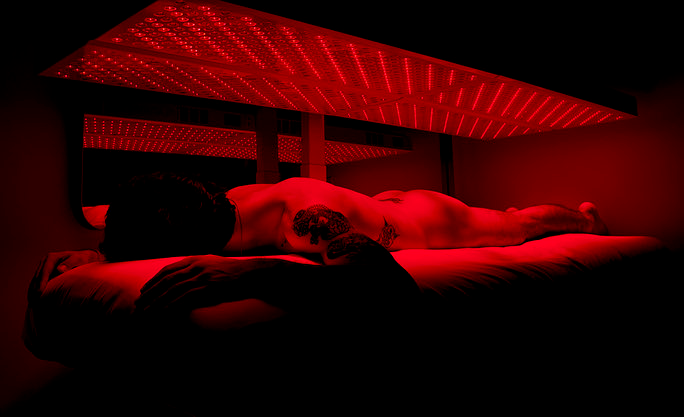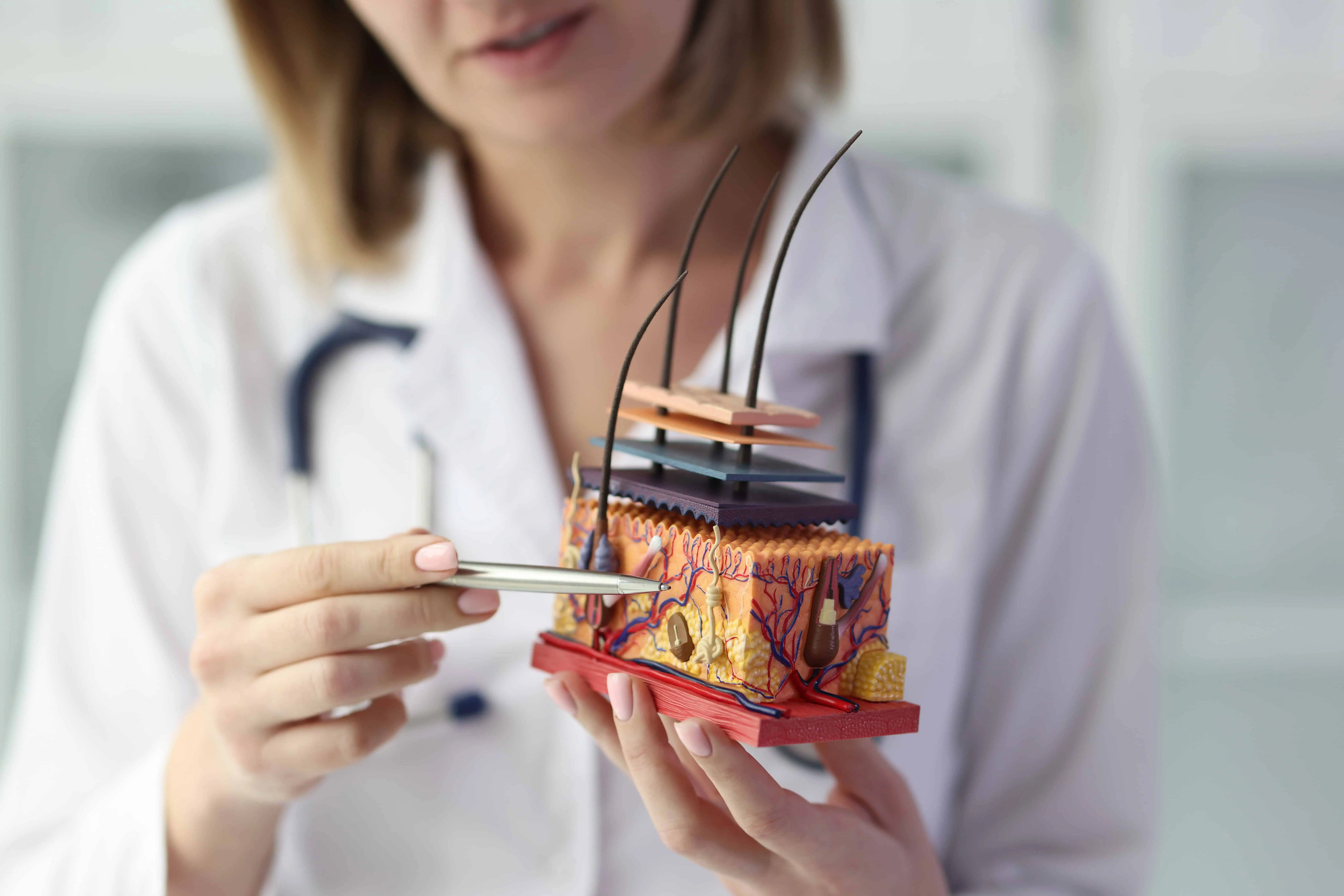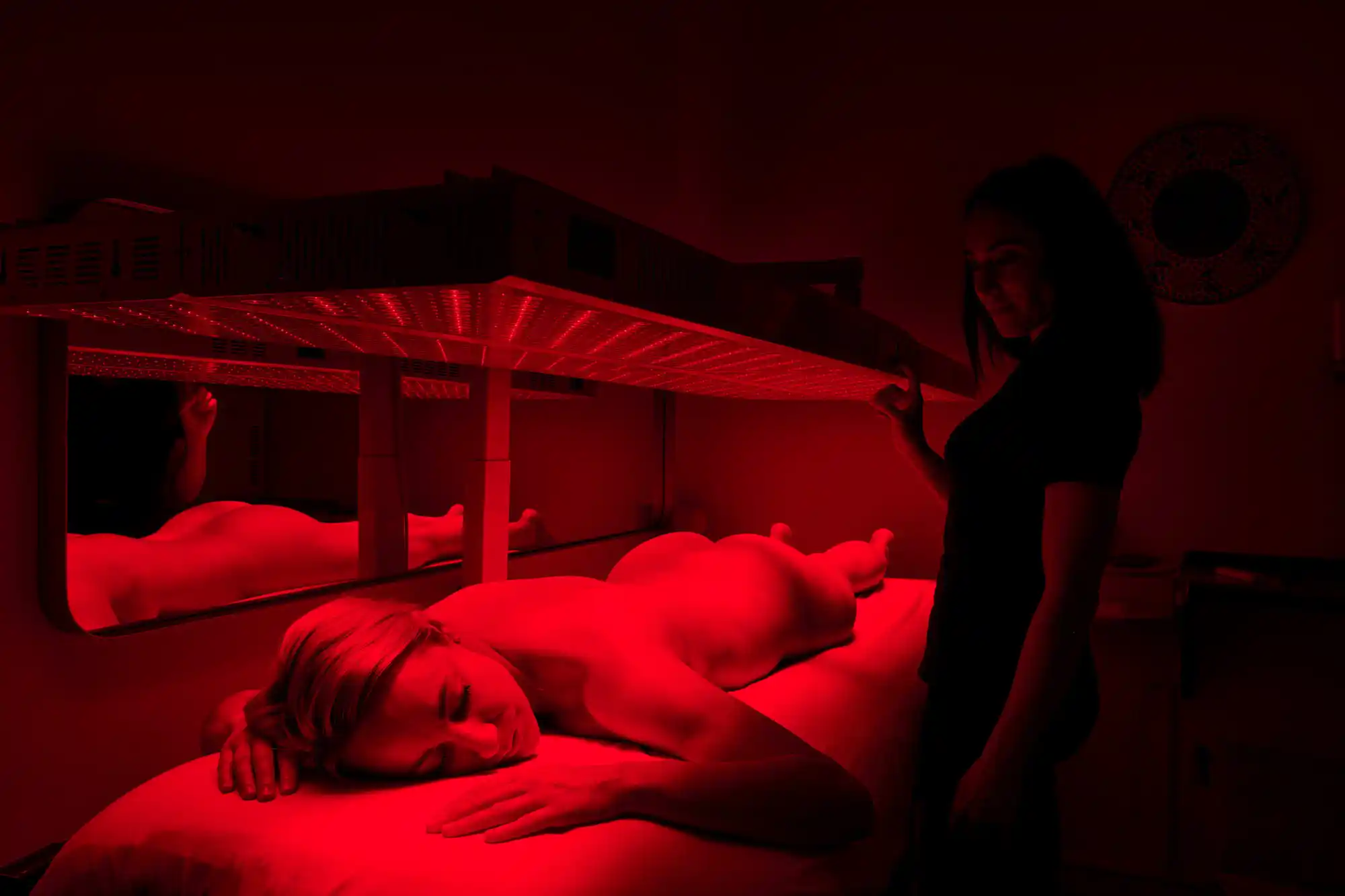Medically reviewed by Dr. Lauren Weber
Did you know that nothing heals in space? Even the most minor scratches don’t correctly heal until an astronaut returns to Earth. The mitochondria, the powerhouses of our cells, are responsible for supplying the energy needed for healing, but they don’t function as efficiently in zero gravity. Well, unless they’re exposed to Red and Near-Infrared Light.
This eureka moment launched decades of NASA-sponsored research. While on a scientific mission to investigate strategies for growing plants in space, astronauts reported the surprising effect of Red Light on their scratches. They began to heal!
Join us on a voyage to discover some perplexing benefits of Red Light Therapy (RLT) for your skin’s health! Your skin is the largest organ in your body and its first defense to the outside world.
We are using Red Light Therapy to encompass both Red and Near-Infrared Light.
Before getting into the nitty-gritty of how Red Light Therapy works, let’s deeply dive into some common skin conditions that might benefit from it.
Psoriasis
Psoriasis is a chronic autoimmune skin condition. It occurs when an overactive immune response speeds up the skin cell turnover process. As a result, new skin cells accumulate faster than old ones can shed, leading to the formation of thick, red, and often scaly patches on the skin’s surface, known as plaques. Plaques can appear on any body part but are most commonly on the elbows, knees, scalp, and lower back. The cause of psoriasis is not fully understood. Still, genetics, seasonal changes, skin injury, climate, immunocompromised state, and the use of some medications have been linked to different types of psoriasis.
Eczema
Eczema is a common chronic skin condition under the term dermatitis. Its signs are inflammation, redness, itching, and dry, scaly patches on the skin. Eczema often makes the skin more prone to irritation. Allergens, stress, weather changes, and certain foods can all cause eczema flare-ups. Avoiding triggers can be helpful.
Rosacea
Rosacea primarily affects the face. It causes redness, visible blood vessels, and sometimes small bumps resembling acne. Triggers for rosacea flare-ups include sunlight, heat, spicy foods, alcohol, menopausal hot flashes, and stress.
Dermatitis
Dermatitis is a rash that occurs due to inflammation of the skin. Various factors, such as exposure to irritants, allergens, infections, and genetic predisposition can cause it. The symptoms of dermatitis typically include redness, itching, swelling, and skin lesions.
Acne, Warts, and Viruses
We all know what acne is. Pimples, blackheads, cystic, nodules, and whiteheads are some symptoms of this condition. There are a few reasons for acne: excess oil (sebum) production, Propionibacterium acnes (bacteria), and inflammation. Acne is formed when hair follicles are clogged with oil and dead skin cells, leading to inflammation. Acne can be made worse by diet, stress, medications, and hormones.
Warts are caused by the human papillomavirus (HPV). They look like rough growths on the skin’s surface but can grow into cauliflower-looking growths. There is a vaccine for some HPV strains, Gardasil-9, approved up to age 45. This also helps protect against strains that increase the risk of many cancers.
For those that suffer from Herpes Simplex Virus I or II, Herpes infections are very common. It is estimated that 50-80 percent of American adults have oral herpes (HSV 1), which causes cold sores or fever blisters on or around the mouth. You can have HSV 1 or 2 orally or genitally. HSV can get passed when there is no outbreak. Skin-to-skin contact is the most likely transmission.
Sun-Damaged Skin
Excessive exposure to the sun can age your skin. Wrinkles, fine lines, and age spots can appear. Your skin is also at risk of losing its elasticity. Sun-damaged skin from repeated UV exposure increases your risk for skin cancers. Now, we have less ozone, we need more protection and for longer. Photodamage can come from natural sunlight (UV radiation) or artificial tanning beds or lamps. UV radiation can destroy things, including DNA.
If you have any new moles or growths on your skin, please remember not to self-diagnose. Make sure always to consult your doctor to determine what the condition is accurately.
Androgenic Alopecia
A hereditary form of hair loss that follows a specific pattern, with gradual thinning and receding of the hairline in men and diffuse thinning of the crown in women.
Anti-Aging
As we age, we lose collagen, even more so going into menopause. The Lights help produce fibroblasts, which make collagen and elastin, the strength, plumpness, and elasticity of our skin. The Lights help with circulation and decrease inflammation of the skin. The Lights help make your skin more resilient, especially against UV damage.
Red Light Therapy and Skin Health
Lasers deliberately damage the skin to initiate a response that produces collagen, which helps resurface the top layer of the skin and can help with wrinkles and sun damage. This is invasive as you have to damage the skin for benefit.
RLT does not follow the treacherous path of harming the skin as lasers, ablative or non-ablative. With it, you can avoid discomfort, a recovery period, and potential swelling. On the contrary, RLT should be utilized before and after these procedures. RLT stimulates the mitochondria, enhancing cellular functions like healing and healthy growth. Let’s look at how it helps address the various skin conditions we looked at earlier.
A study published in 2020 in the Journal of Drugs in Dermatology discovered that Red Light Therapy enhances fibroblasts, cells responsible for generating collagen and elastin. This, in turn, contributes to the skin’s structure, resilience, and elasticity. Collagen helps with fine lines and wrinkles.
Skin fibrosis, or scarring, affects over 100 million individuals globally annually. RLT could mitigate collagen production in scar tissue, preventing the development of thickened scars.
Red Light Therapy accelerates the healing process of wounds. Researchers highlight the upsurge in cellular mitochondrial activity, the proliferation of fibroblasts, and collagen synthesis as beneficial effects of Red Light Therapy on wound healing. It also minimizes inflammation and free radicals and augments blood flow and circulation to the skin and scalp, increasing the nutrient supply. Consequently, this helps treat the various skin conditions above, enhancing skin plumpness, hair growth, thickness, and density and minimizing stretch marks. This also helps to improve the sun-damaged skin and age spots.
Acne is combatted both with RLT and Blue Light. At Deeply Vital Medical, we have Blue Light in our face panel. Blue Light helps to eliminate the bacteria that cause acne. This specifically optimized wavelength differs from the Blue Light emitted from electronic devices.
Using RLT, HSV 1 and 2 outbreaks are treated faster with less pain. If you feel an outbreak coming on, get scheduled to get under our whole-body Red Light Therapy panels! Once you have an outbreak, consider our HSV Be Gone Package!
Sounds Amazing! It is! Any Restrictions? Few!
If you are sensitive to Light or take photosensitive medications, you may use Red Light Therapy with caution.
At present, Red Light Therapy isn’t recommended for pregnant women as its effects on pregnancy haven’t been thoroughly studied. It’s plausible that Red Light is safe to use, whereas Near-Infrared Light may not be suitable due to the heat it generates.
Is Red Light Therapy Proven to Be Effective? Yes, very!
There are decades of studies showing safety and no significant side effects. Red Light Therapy devices are typically not lasers anymore. They are LEDs, making them safer. Unfortunately, studies on Red Light Therapy still have limitations. Many of these published studies had a small sample size, lacked a placebo group, were carried out on animals rather than humans, or were limited to cellular tissue experiments. While we and many are enthusiastic about the findings, we need more high-quality studies involving more significant participant numbers, various ethnic backgrounds, and illnesses to draw more robust conclusions and protocols. It is time to stop suffering and start healing!
The good news is we’ve got something exciting to look forward to in the coming years as research into Red Light Therapy accelerates. Let’s wish the scientists a hearty Godspeed, or shall we say a warm Lightspeed?
At Deeply Vital Medical, we want you to experience the healing magic of whole-body Red Light Therapy with personalized attention from Dr. Weber. If you have any skin conditions, whether we’ve discussed them here or not, visiting us can help. Contact us today to book your free 10-minute phone consultation. Dr. Weber will review your situation and recommend the best strategy.
References:
Link 1






